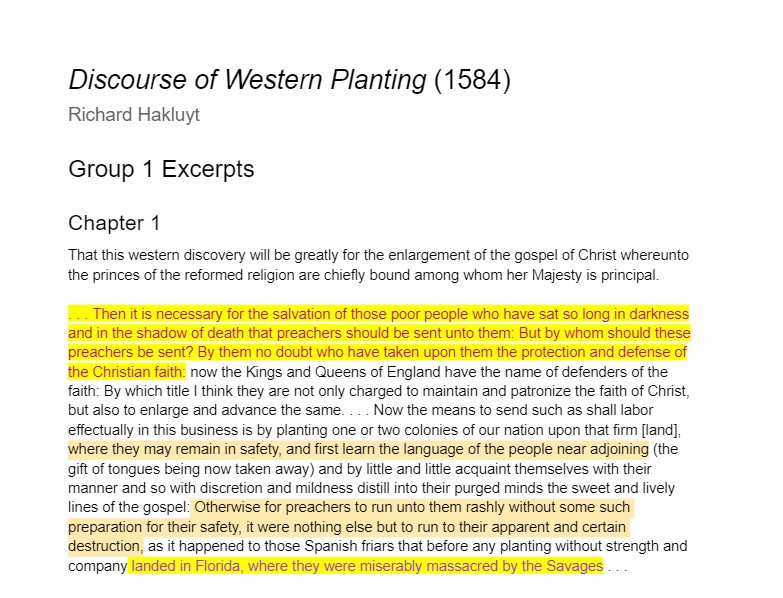Sarah E. Naramore
Introducing undergraduate students with little or no experience in college-level history courses to primary sources is a daunting task. I teach at a small regional public university in Missouri. Most of my students in any given semester have no interest in pursuing history beyond their required “Northwest core” class, in my case United States History to 1877. Like many students they approach the subject as one to “like” or “dislike” or find alternately “boring” or “interesting.” Part of this, I suspect, stems from history classes that teachers design to “cover” information. Most of us in grade school had history presented to us like a complete narrative, a set of instructions on how to do things or not to do things to keep history from “repeating itself.” I personally don’t remember “doing” history or having history presented as something that was created by historians, changed, or could be debated. We “did” math, science, and English, we “covered” topics in history.
This preamble brings us to the purpose of this blog: how Hakluyt fits into a history survey course. In an effort to break the pattern of history as a subject learned rather than made, I make practicing historical skills a key part of my introductory level courses through “lab” assignments. The wording is intentional. My hope is to convey the active nature of historical scholarship and play with the similarities between history and the sciences (disciplines that the majority of my students are studying). With a Monday, Wednesday, Friday schedule Fridays become the default laboratory days. Students work in groups of five to six of their peers to complete specific assignments that exercise historical skills including primary and secondary source analysis, close reading, supporting arguments, and creative historical thinking. Assignments are all imported into the course Canvas site and assignments are turned in using the LMS. While contained rather than original research, students work in teams to answer open-ended questions and work through assignments.
Each semester in my US history survey course I include a “lab” assignment using selections from Richard Hakluyt’s Discourse of Western Planting from 1584 in the second or third week of the course. We begin with discussions of North America, Europe, and Africa in the centuries preceding colonization and then move into questions of why European countries engaged in exploration, contact, and migration to North America. As such, the Hakluyt reading not only acts as a formative assignment but reinforces key themes we address early in the course. However, it also serves as a first primary source for many students and a difficult read for most. This allows students not only to dig into historical reading but also work together to understand its meaning.

In the most recent version of this lab, I created google docs for each group that included the passages selected for analysis. These included the title of each chapter from Discourse and a few sentences to help provide context for the chapter arguments. While my approach does not give students a deep reading of the text, they do have the opportunity to look at and understand the contours of the work as a whole. For a first-time primary source reading I want students to have some sense of a beginning, middle, and end. By comparing different chapters, they are able to understand how Hakluyt built arguments and the variety of reasons the English considered the creation of permanent American colonies. The goal is for students to read and understand what Hakluyt was trying to do and why by putting the writing in the greater context of the sixteenth century. By using google docs students can digitally annotate as a group and ask each other questions. After time for free discussion and annotation students are asked to answer the following questions as a group.
- What do these selections tell us about Hakluyt’s interests and concerns?
- What are his main arguments?
- Who do you think his audience was? Who was it supposed to convince and of what?
- Who might have disagreed with Hakluyt’s interpretation of events?
- What conclusions might a historian draw from this document about the history of colonization?
Each question again allows for discussion and is open-ended to allow for individual questions, interests, and concerns to come to the forefront. By the time students read Discourse they have been introduced to some basic economic, political, and religious motivations for colonization as well as some background on the Protestant Reformation in England. This information is by no means extensive but should provide a solid background for putting Hakluyt in context. Meanwhile, the clear chapter and arguments presented in the text reinforce the general ideas we have approached in the classroom. Upon reflection it is my hope that we can turn the conversation toward question five and think about how historians have used this source and other like it to come to the conclusions found in our textbook.

Student responses to these activities are not always easy to evaluate. Many note the difficulty of the reading itself and the time it takes to work through sources. Some point out the utility of such documents to understand the broader arguments of the course. Despite the difficulty of Hakluyt’s prose for the untrained undergraduate, however, I can say some things for certain. By having them use google docs to annotate collectively they work on their reading and note-taking skills. For a generation of students still reeling from the isolation of COVID-19 the option to write their thoughts rather than speak them is appreciated early in the semester. While Hakluyt is not an obvious figure to spend time on in a US history survey — one in which we need to reach the end of Reconstruction in fifteen surprisingly short weeks – Discourse works remarkably well as a framework for considering much of our first unit and setting up an important group reading and working dynamic.
